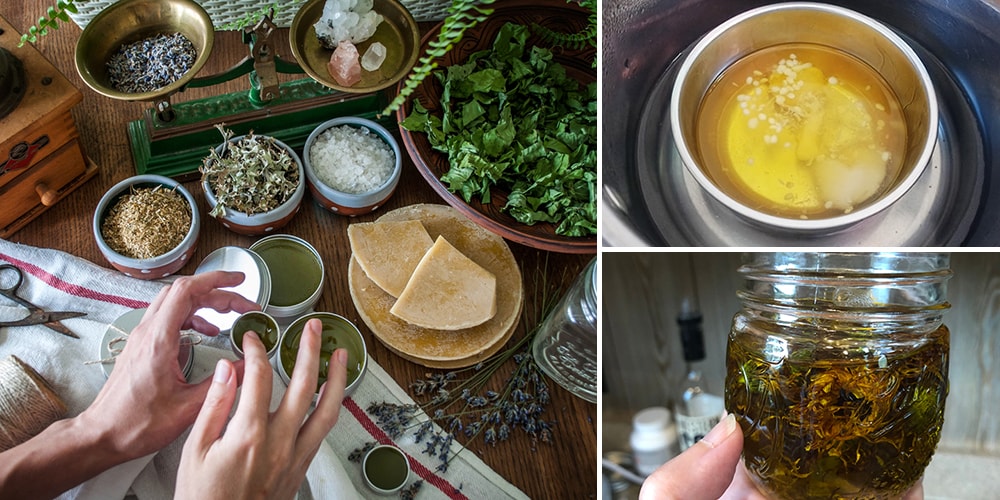
10 Healing Salves from 100 Years Ago
Whenever we have sore muscles, skin problems, wounds, bites, or stings, salves are our best friends in easing them. It has been the same with our forefathers ages ago. But instead of the chemical-laden OTC ointments we have today, they had natural remedies they prepared themselves from herbs.
Salves have existed for centuries. They were often concocted from locally sourced herbs and spices. They are still popular among patients although not as famous among physicians. So let’s see what were the common salves people used back then.
Some of The Best Herbs for Salve-Making
Arnica: Arnica (Arnica montana) is one of the longest-used medicinal plants since the 1500s. It is used to treat wounds, bruises and blunt injuries. Arnica is used as a cream or salve. It is rarely taken orally as it may cause dizziness and heart irregularities. Some may take it as an infusion to relieve muscle strain and internal inflammation, but in small amounts.
Marigold: Marigold (Calendula officinalis) is a traditional plant that is locally applied to soothe and reduce the itching in chicken pox. It is also excellent in treating eczema, skin allergies and other skin problems. Fresh marigold flowers and their oil extracts can promote faster healing of wounds and reduce inflammation and pain.
Lavender: Lavender (Lavandula angustifolia) is a powerful herb against neurological problems, sleep disorders and dermatological conditions. The lavender salve is used for calming the senses and inducing a sound sleep. It is mostly used as a massage oil or balm to encourage quality sleep and relaxation.
I personally prefer to grow my own Lavender and Calendula plants, because they’re helpful for a wide range of common ailments. For buying quality seeds, I recommend this kit.
Aloe Vera: Aloe Vera is a tested and proven plant that brings therapeutic benefits to all sorts of skin problems. The gel is generally applied directly by rubbing it on the skin. It is also a popular ingredient in many cosmetic creams and salves.
Cayenne Pepper: Cayenne salve is a topical remedy for soothing muscle and joint pains. Cayenne pepper powder can be infused in a carrier oil and mixed with beeswax. It is a natural anti-inflammatory topical that can be used even for pregnancy-related joint and body pains.
Turmeric: If you have sore joints, swelling, skin tags and unwanted skin growth, turmeric is an excellent solution. Turmeric (Curcuma longa) can significantly reduce pain and skin overgrowth when used as a salve. When infused with carrier oil and wax, turmeric gets absorbed into the skin to heal many health issues.
Tea Tree Oil: Tea tree oil extracted from the Melaleuca alternifolia tree is one of the best topicals for acne. Tea tree oil is a sensitizing agent that cures skin issues without the dryness, itching and irritation that chemical salves cause, but make sure to always dilute it in a carrier oil.
Rosemary: A salve of rosemary may help stimulate hair growth for the treatment of alopecia aerata. It is applied directly on the scalp to increase the hair count in both male and female pattern baldness. Rosemary also brings other benefits like relieving stress and improving cognitive function.
Peppermint: Peppermint salve is loaded with an analgesic property that deals with sore muscles and body pains. It is a traditional revitalizer that can soothe the senses with its cooling fresh scent. Peppermint (Mentha piperita) is a versatile herb that is also used for alleviating respiratory problems, digestive issues and mental distress.
Witch Hazel: Witch hazel (Hamamelis virginiana) has an astringent and antiseptic action. It has a high concentration of tannins, which helps remove oils and clear skin blemishes. In the old days, people used witch hazel as a poultice to reduce fever and inflammation. Today, it is an ingredient in cosmetic products for treating bruises, sunburns and varicose veins.
How Are Herbal Salves Made?
The methods of making herbal salves in the past were often based on traditional knowledge and practices. Our forefathers gathered medicinal herbs, dried them for long-term storage, and infused them in carrier oils.
Here is a simple salve recipe with Calendula infused oil, using the “cold” infusion method.
Ingredients:
- 1 cup dried Calendula flowers
- 2 cups carrier oil (such as olive oil)
- 1/4 cup beeswax, grated
Steps:
Infusing the Oil: Place the dried Calendula flowers in a clean, dry glass jar. Heat the carrier oil gently in a double boiler or a heat-resistant bowl placed over a pot of simmering water. Pour the warm oil over the Calendula flowers in the jar until they are completely covered. Stir gently to remove air bubbles and ensure the flowers are submerged. Seal the jar tightly and place it in a sunny place for 4-6 weeks to allow the oil to become infused with the Calendula properties. Shake the jar occasionally.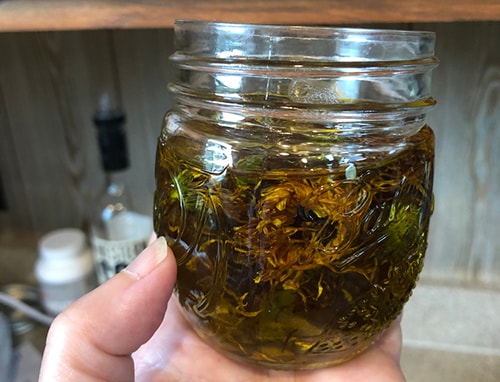
Straining the Oil: After the infusion period, strain the oil through cheesecloth or a fine mesh sieve to remove the plant material. Squeeze out as much oil as possible from the flowers.
Creating the Salve: In a double boiler, melt the beeswax over low heat. Once the beeswax is melted, add the strained Calendula-infused oil to the double boiler and stir well to combine. If desired, add a few drops of essential oil for fragrance and additional benefits.
Testing the Consistency: To check the consistency of the salve, place a small spoonful on a plate and let it cool for a minute. If it’s too soft, add more beeswax; if it’s too hard, add more oil. Adjust until you achieve your desired texture.
Pouring and Cooling: Once you’re satisfied with the consistency, pour the mixture into clean, dry jars or tins. Allow the salve to cool and solidify completely before sealing the containers.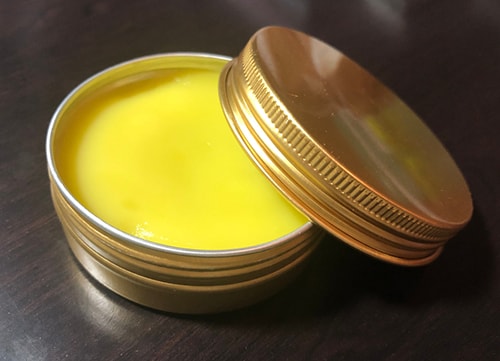
Labeling: Label the jars with the date, ingredients, and purpose of the salve.
Thickening Agents in Salves
Waxes, either plant or animal-based, create the firm texture of salves. A salve is similar to a balm, but softer in texture.
If you want to make your own salve, you have different options for thickening agents like:
Beeswax: It is the most popular and the earliest-used stiffening agent for salves. These are obtained from honeycomb and are available in yellow, white or absolute. Yellow beeswax is soft and is ideal for salves. Whites are heat resistant and are best for candlemaking. Absolute beeswax are yellow beeswax treated with alcohol and are great for perfumery.
Carnauba Wax: Carnauba wax is a vegan wax made from palm. It is used as a thickener and gel agent for its hardness and high melting point. Carnauba produces a high polish, making it useful not only in cosmetics but also in leather, furniture and other material polish.
Candelilla Wax: Candelilla is also a vegetable-based wax with protective and softening properties. When used in salves, it easily gets absorbed into the skin for excellent skin conditioning and moisturizing. Unlike other waxes, candelilla exudes a pleasant scent and produces a translucent salve.
Tallow Wax: Tallow is an animal-based wax often derived from lards of sheep, cows or whales. When used in salves, it provides a lubricating effect to help with chapped and dry skin. Tallow has a waxy odor and is also used in cosmetics and candle making.
Soy Wax: Soy wax creates salves that are lightweight and are barely noticeable when applied. It melts faster than beeswax but solidifies with the same firmness when cooled. Most soy wax sold is for candle making, so be sure to get a skincare grade if you want to use it for topicals.
Butter Blend: Salves can also be made using plant butter like shea and cocoa butter. These butters create a semi-firm salve and are known to bring more skin health benefits. Shea butter is thicker and is best for hydration and reducing skin blemishes. Cocoa butter is best for sensitive and inflamed skin and is commonly used for its chocolate-like scent.
All-Purpose Healing Salve
This recipe is an all-around salve adapted to the modern times, with ingredients anyone can source easily online, in apothecary shops or health food stores. It is made from plant butter and essential oils that work great as a skin moisturizer and healer.
With the cooling and soothing presence of peppermint, you can also apply the salve on tired and sore muscles.
You need:
- 1 tbsp coconut oil
- ½ tbsp beeswax
- 2 tbsp cocoa butter
- 1 tbsp shea butter
- 15 drops lavender essential oil
- 15 drops peppermint essential oil
- 10 drops sweet almond oil
- 10 drops castor oil
- 10 drops vitamin E oil
- Double boiler or heat-resistant bowl for melting
- Salve container
Steps:
- Place the coconut oil, beeswax, cocoa butter and shea butter in a heat-resistant bowl or cup. Place the cup directly over a pan of boiling water to melt the ingredients. Or, you can use a double boiler for melting.

- Remove from heat and let cool for about 10 minutes.

- Add the lavender, peppermint, almond oil, castor oil and Vitamin E. Vitamin E is optional but helpful if you want to extend the shelf life of your salve.
- Mix everything well and transfer the blend into your salve container. Let it sit for about an hour to cool and take shape. Label the jar. Store it in a cool, dry place, or in the refrigerator, where it can last for 1 to 2 years.

How to Use
Apply a liberal amount and gently massage the salve on the affected area. You may also use it as a lip balm for chapped and dry lips. Use the salve before bedtime to alleviate stress and help you sleep soundly for the night.

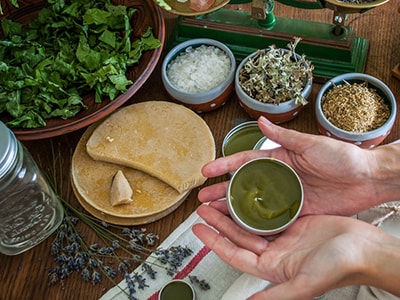
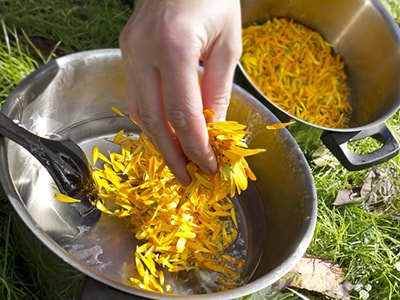
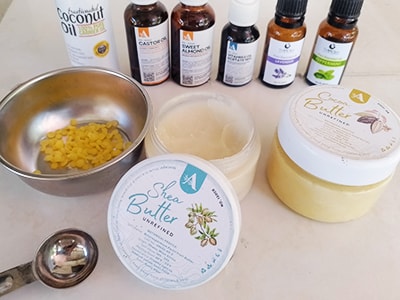
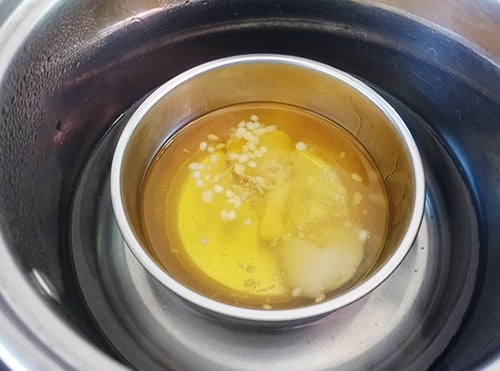
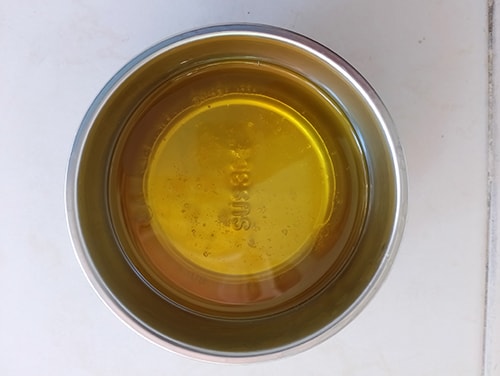
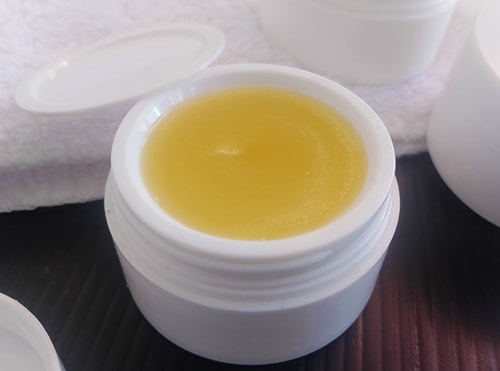
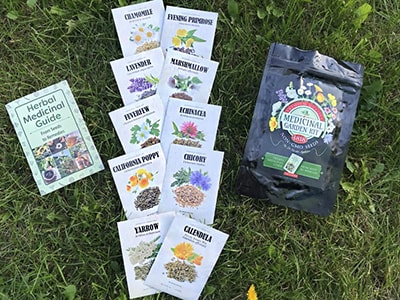
How long the this calendula salve made from this recipe last?
If you added about 10 drops of Vit E oil it would last about a year or maybe more if kept at moderate room temperatures.
What happens if you use Tea Tree oil directly on your skin without a carrier oil? I have used it directly on blemishes, but haven’t noticed any ill effect. Does it do something to me that is harmful that I cannot see right away or is the carrier oil a preventative in case I have sensitive skin?